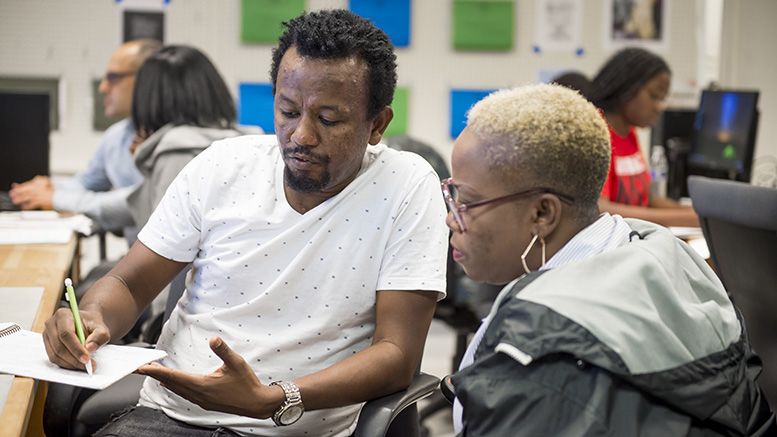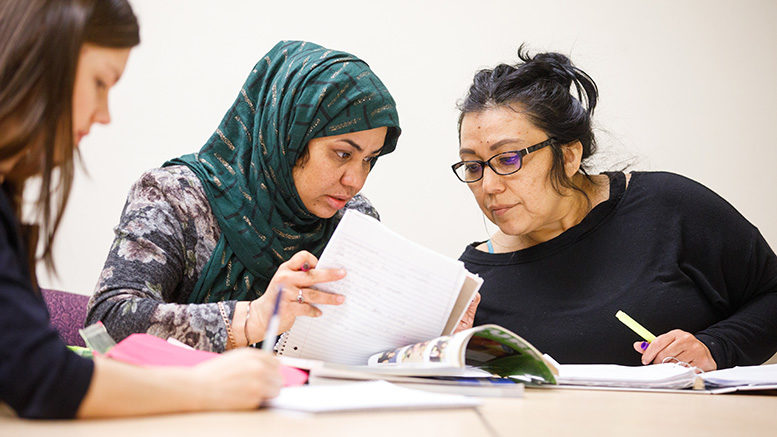Mt. Hood Community College’s newest career path for its region’s large contingent of refugees and other immigrants began — as many things do — in Las Vegas.
Some of the college’s leaders had joined other community members on a field trip to the United Brotherhood of Carpenters’ sprawling International Training Center there. As they sat down to dinner, Miguel Montaño, assistant director of the Pacific Northwest Carpenters Institute, the union’s training arm, mentioned an issue that’s been on his mind.
The union is working hard to create new pipelines of future workers, he said. But few refugees and other new Americans apply to its apprenticeship programs. Those who do struggle with language barriers. They are the group most likely to leave apprenticeships in the first year.
“They may have the skills to be able to join us,” Montaño said. “But sometimes our classes can be a little complicated with the language and terminology. And that’s where they start to fall behind.”
The Oregon college’s staff jumped on the opportunity. The adult basic skills department set about creating a pre-apprenticeship program that will immerse new immigrants in the vocabulary, expectations and culture of the construction trades as part of their English language learning. Although it is still seeking funds to fully get rolling, the fledgling program recently received $100,000 from the U.S. Department of Education’s “Rethink Adult Ed Challenge.”
“Our area has a growing population of new Americans,” said Kelley Keith, dean of adult basic skills and career pathways. “I think and see, as do many employers, that this is our future workforce.”
A potential pool of workers
Around the nation, other community college leaders see the same picture. The demand for workers in fields like childcare, health care and construction is acute. To meet the needs, employers and colleges are looking toward immigrant and refugee populations — where motivated adults often languish in low-paying factory and processing jobs because they don’t speak fluent English.
This pool of prospective workers is expected to increase as a result of this fall’s massive airlift of Afghan evacuees and also the Biden administration’s decision to raise the cap on admissions of international refugees to its highest level in years.
“Newcomers are likely to be directed toward community colleges. We’re a point of entry for them,” said Teresita Wisell, vice president for workforce development and community education at Westchester Community College in New York.
Wisell is also executive director of the Community College Consortium for Immigrant Education, a collaboration of colleges and partners, including the American Association of Community Colleges, that acts as a resource for schools seeking better ways to serve immigrant populations.
“Much of the work that’s happening in a really effective way integrates English language learning with workforce training,” Wisell said.
Educators refer to that approach as “contextualized learning,” and model programs can be found around the nation. Pima Community College in Arizona offers English language instruction with an emphasis on the vocabulary and protocols common to workplaces. Miami Dade College in Florida integrates language classes with training for jobs in fields like phlebotomy, private security and information technology. Washington state’s publicly funded career and technical colleges offer fast-track programs where language education is regarded as a means to college credits or workplace certificates.
Getting the work lingo down
Mt. Hood Community College (MHCC) has a thriving program in which new immigrants learn English while simultaneously acquiring the knowledge and vocabulary they’ll need to earn credentials in the early childhood education field. The college has also offered integrated language and workforce training courses for nursing assistants, welders and accounting assistants.
Colleges that use contextualized learning say it provides a faster track to job credentials and college credits than the traditional model — which requires students not fluent in English to master ESL classes before moving into credit courses or job training programs. Students often struggle to complete ESL tracks. And those who do may still lack the vocabulary to succeed in fields like healthcare and construction.
“There aren’t that many contextualized ESL classes for the population of folks that we know exists,” said Debra Means-West, with the World Education Services’ Global Talent Bridge program. “That’s why we try to shine a light on more of those promising practices, because the success behind it is certainly evident.”
West’s program seeks to help high-skilled immigrants put the education and credentials they’ve obtained in their home countries to better use in America, where even the most successful professionals from abroad are often expected to start from square one.
“Community colleges are a very crucial ally in this work,” West said.
Wisell said she was encouraged to see community colleges partnering with initiatives like Global Talent Bridge.
“I think the community college role is to help meet our labor force needs by helping to bridge whatever gaps there are in a new arrival’s skill set,” she said. “Refugee advancement is not only the right thing to do, it’s untapped potential.”
Not easy work
For colleges, though, serving refugees from disparate nations, cultures and skill sets is costly, difficult work.
“A refugee student may come in at a lower level and start with a language class at our refugee center,” said Donna Kinerney, dean of instruction for adult ESL and basic skills programs at Montgomery College in Maryland’s fast-growing Washington suburb. “They may come in at an upper level. So we really have to build in a lot of places where people can come into the system.”
Kinerney and her staff work closely with refugee resettlement agencies to figure out the best path for prospective students. They waive tuition for many of their programs and invest in case management services. They receive solid support from state and local governments and cultivate community partnerships. And, like other colleges that work successfully with refugees, they chase every grant they can find.

Contextualized learning courses can be especially costly because they require two instructors — someone to teach the basics of a trade or job, and an ESL teacher to help students understand what’s going on, either by working alongside the other instructor or through separate support classes.
Those courses also require an investment on a student’s part.
“Our students take a support class for every credit course,” said Kristen Kulongoski, manager of adult basic skills and career pathway at MHCC. “So they’re essentially doubling the amount of time that they’re studying. It allows that acceleration, but it also requires a significant commitment to the program.”
Wisell, who immigrated from Cuba with her family as a child, said the return on investment on the part of colleges and students can be huge. “I know the generational impact of what can happen when immigrants and refugees are welcomed and supported and advanced in their communities,” she said. “Not only what that means for a family, but what that refugee family gives back to the community in which they live. The work is important and community colleges play an integral role.”

